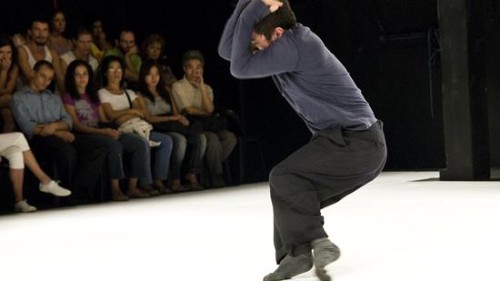
Celebrated Brazilian dancer Eduardo Fukushima dazzles audiences at the Toronto Luminato Festival
Hailing from Brazil, Eduardo Fukushima brings two of his celebrated solo dance pieces in an hour-long performance with Between Contentions and How to Overcome Great Tiredness?. This double bill of dance is a part of Luminato Festival’s 7 Monologues. Joined together, the two pieces create a series of intriguing contrasts.
The performance opens with Between Contentions – a piece that starts in silence, and with minimal movement. Fukushima slowly builds on a small number of simple, repeated gestures to create the overall tone of the piece. He alternates between dancing in silence, to moving to Cat Power’s “Back of Your Head”.
How to Overcome the Great Tiredness also starts in silence with minimal movement, but the silence is abruptly interrupted by an experimental composition by Fukushima and Felipe Ribeiro. Like the first piece, this performance builds on a series of repeated gestures.
Both dances are engaging, emotionally raw pieces on their own, and Fukushima made a very interesting choice to bring them together in one performance experience.
The movement of Between Contentions is characteristically light — even playful — despite the fact that the emotional tone is far wearier. Fukushima’s movements are airy, and have him primarily standing.
The lighting is warm and dim, and the music serves as a melodic backdrop that doesn’t outshine the movement. In fact, the choice of gentle music (and the fact that the movement continues uninterrupted when the song ends) serves as a reminder that the music is arguably negligible, save to break up the gaps of silence.
One final aspect of Between Contentions worth noting is Fukushima’s use of his own breath (i.e. exaggerated inhales and exhales), which contribute to the piece’s soundtrack.
In contrast, How to Overcome the Great Tiredness? features Fukushima moving in a way that pulls him to the ground. It felt like he was perpetually trying to lift off from the ground to no avail.
Unlike the sounds of the first piece, the bass-heavy, loud, experimental “music” (in a non-pejorative way, I would really call it noise), doesn’t allow for the audience to drift off into contemplation in the same way that the first piece does.
As soon as the music starts, you get sucked into Fukushima’s emotionally (and physically) intense movements. It’s also worth noting that the piece features bright, stark, lighting.
In Great Tiredness, Fukushima aims to push himself to the point of complete physical fatigue. Unlike Between Contentions, he conserves no energy here and seems to dance himself to emotional oblivion.
Similar to the first piece, the sound of Fukushima’s breath –- and towards the end of the piece, the sounds of his physical pain and fatigue –- contribute to the soundtrack.
For those seeking entertainment in dance performance, the performance may feel tedious with its use of repeated gestures. It’s also worth noting that the music used in the second dance may be overly stimulating for some, and even monotonous for others.
The strength of both pieces is that they present emotionally raw contemporary dance laid bare. Fukushima has a characteristic lack of complicated costume, lighting and sound, set pieces, and most importantly, movement.
Details:
- Between Contentions and How to Overcome the Great Tiredness? played until June 21 at Harbourfront Centre Theatre (231 Queens Quay West)
- Though the performance’s run has completed, you can learn more about Eduardo Fukushima’s upcoming work by visiting his website or find other shows at the Luminato Festival.
Photo by Inês Correa
